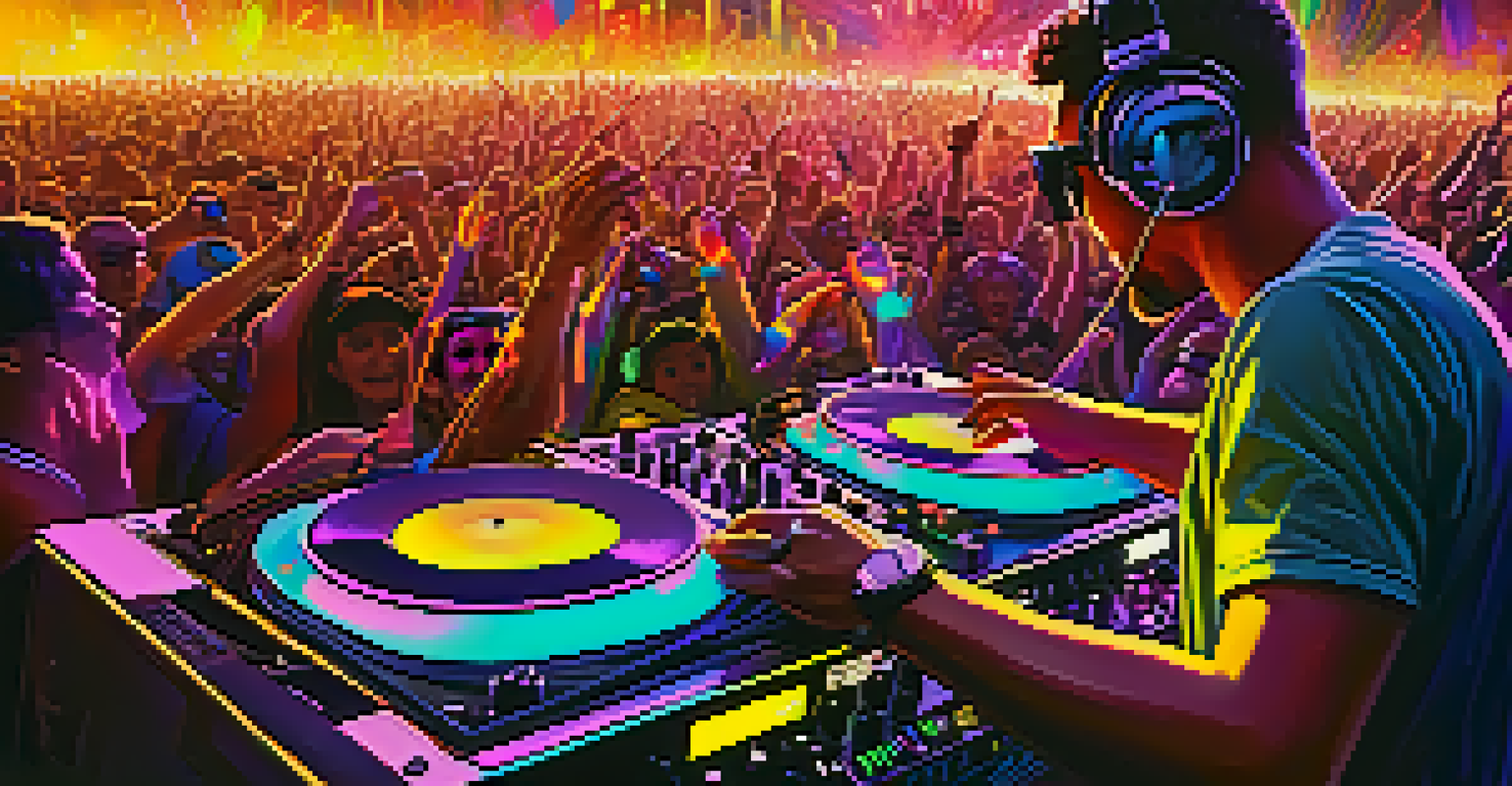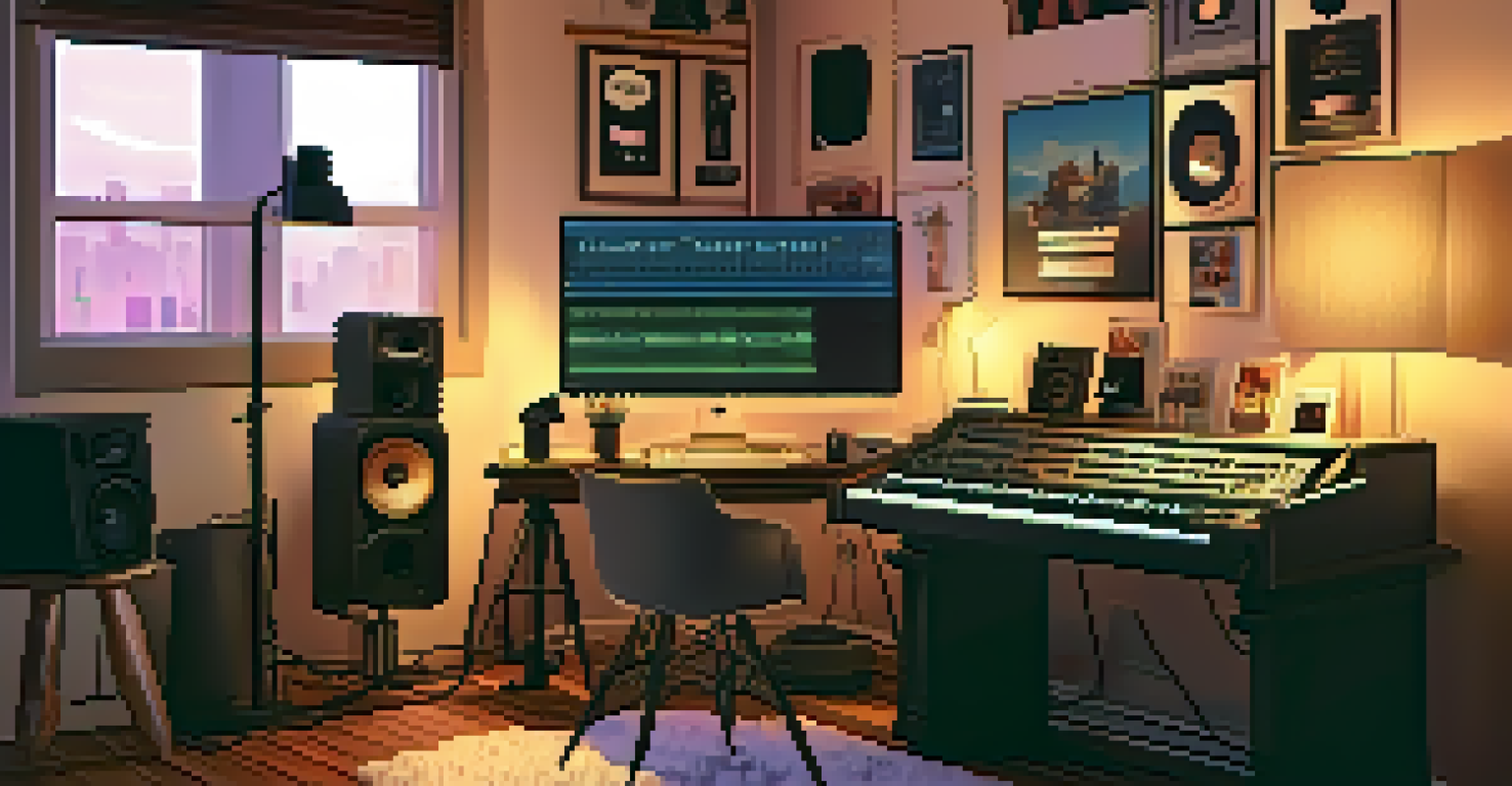Electronic Music: From Underground to Global Phenomenon

The Humble Beginnings of Electronic Music
Electronic music has roots that trace back to the early 20th century, with pioneers experimenting with synthesizers and tape recording. Initially, it was an underground movement, often associated with avant-garde art and experimental soundscapes. Artists like Karlheinz Stockhausen played pivotal roles in shaping this genre, pushing boundaries that would influence future generations.
The music industry is a series of revolving doors, and the key to unlocking them is creativity and innovation.
As the 1970s rolled in, electronic music started to gain traction in popular culture, particularly with the rise of disco. Clubs began to embrace this new sound, creating an environment where DJs like Giorgio Moroder could thrive. This period marked the transition from purely experimental compositions to danceable tracks, making electronic music more accessible to the general public.
By the late 1980s, genres such as house and techno began to surface, further solidifying electronic music's presence in nightlife. The underground scene boomed in cities like Chicago and Detroit, where local DJs crafted unique sounds that would eventually reach a global audience. This was the birth of a new culture, one that would redefine music consumption and production.
The Rise of Rave Culture
The late 1980s and early 1990s saw the emergence of rave culture, a phenomenon that connected electronic music to a sense of community and escapism. Raves were often held in warehouses or outdoor locations, creating a liberated space for self-expression and dance. With pulsating beats and vibrant visuals, these events became a sanctuary for those seeking an alternative lifestyle.

As rave culture expanded, so did the popularity of electronic music. Iconic festivals like the Love Parade in Berlin and the UK’s Tribal Gathering drew massive crowds, showcasing the genre's ability to unite diverse groups of people. These gatherings not only highlighted the music but also celebrated the culture surrounding it, including fashion, art, and a sense of belonging.
Electronic Music's Rich History
From its avant-garde beginnings to mainstream acceptance, electronic music has evolved through technological advancements and cultural shifts.
However, the rise of rave culture wasn't without its challenges. Authorities often viewed these events with skepticism, leading to clashes between organizers and law enforcement. Despite this, the resilience of the community only strengthened the bond among fans and artists, fostering a sense of loyalty that would endure through adversity.
Technological Advances Shaping the Genre
Throughout its evolution, electronic music has been heavily influenced by technological advancements. The introduction of MIDI (Musical Instrument Digital Interface) in the early 1980s revolutionized how musicians composed and produced music. This technology allowed different instruments and devices to communicate, enabling artists to create complex soundscapes more easily.
Electronic music is a canvas, and the artist is free to paint their own vision.
Software like Ableton Live and FL Studio has democratized music production, allowing aspiring artists to create professional-quality tracks from their bedrooms. This accessibility has led to an explosion of creativity, with countless sub-genres emerging as artists experiment with new sounds and styles. The barrier to entry has significantly lowered, making it possible for anyone with a passion for music to contribute.
Moreover, the rise of social media and streaming platforms has provided electronic artists with unprecedented opportunities for exposure. With a simple click, a track can reach millions, allowing underground artists to gain global recognition. As a result, the electronic music scene has become more diverse, reflecting a wide array of influences and cultural backgrounds.
The Globalization of Electronic Music
As electronic music gained popularity, its influence spread across the globe, transcending cultural and geographical boundaries. What began as a localized movement in the West quickly transformed into a worldwide phenomenon, with countries like Japan, Brazil, and South Africa producing their own unique sounds. This globalization has enriched the genre, creating a vibrant tapestry of styles.
Festivals like Tomorrowland in Belgium and Ultra Music Festival in Miami have become pilgrimage sites for electronic music fans, drawing attendees from all corners of the world. These events not only showcase renowned artists but also highlight emerging talent, offering a platform for diverse voices in the electronic music community. The global stage has fostered collaboration among artists, leading to innovative fusions of genres.
Rave Culture's Community Impact
The rise of rave culture in the late 1980s fostered a sense of community and escapism, connecting diverse groups through shared musical experiences.
Furthermore, the rise of international music charts has solidified electronic music's place in mainstream culture. Tracks that once thrived in underground scenes are now topping charts, with artists like Calvin Harris and The Chainsmokers achieving massive commercial success. This shift reflects a broader acceptance of electronic music, making it a staple in today’s musical landscape.
The Role of DJs in Shaping the Genre
DJs play a crucial role in the electronic music ecosystem, serving as curators and creators of sound. Their ability to blend tracks seamlessly during live performances has transformed the listening experience, turning music into a communal celebration. Iconic DJs like Tiësto and Armin van Buuren have become household names, demonstrating the power of a skilled DJ to captivate audiences.
In addition to live performances, many DJs are also prolific producers, crafting original tracks that have become anthems for festivals and clubs alike. They often collaborate with vocalists and other musicians, expanding the sonic possibilities of electronic music. This dual role as performer and producer allows DJs to influence the genre’s evolution significantly.
Moreover, the rise of DJ culture has prompted a reevaluation of the artist's role in music. No longer just a figure behind the turntables, DJs are now seen as artists in their own right, contributing creatively to the music landscape. This shift has empowered a new generation of DJs to push boundaries and redefine what it means to be an artist in the electronic scene.
The Influence of Social Media and Streaming
In today’s digital age, social media and streaming platforms have dramatically changed how electronic music is consumed and promoted. Artists can now share their music directly with fans through platforms like SoundCloud and Spotify, bypassing traditional gatekeepers. This direct access has fostered a more intimate relationship between artists and listeners, allowing fans to engage with their favorite musicians in real-time.
Social media also plays a pivotal role in marketing electronic music events. Through platforms like Instagram and TikTok, promoters can reach a broader audience, showcasing festival line-ups and behind-the-scenes content. This visual storytelling not only generates excitement but also helps to cultivate a sense of community among fans.
Social Media's Role in Promotion
Social media and streaming platforms have transformed how electronic music is consumed and promoted, enabling artists to engage directly with fans.
Additionally, viral trends on social media can catapult tracks into mainstream success almost overnight. Challenges, remixes, and user-generated content can introduce new audiences to electronic music, allowing it to reach demographics that may have otherwise overlooked the genre. This evolving landscape highlights the importance of adaptability and innovation in promoting music in the modern era.
The Future of Electronic Music
As we look ahead, the future of electronic music appears bright and full of potential. With rapid advancements in technology, artists are continuously finding new ways to create and share their work. Emerging technologies like artificial intelligence and virtual reality are beginning to shape the music experience, offering endless possibilities for creativity and interaction.
Moreover, the genre's ability to adapt and evolve will be crucial in maintaining its relevance. As audiences become more diverse, electronic music will likely continue to incorporate influences from various cultures and genres, resulting in innovative hybrid styles. This fluidity is one of the genre's greatest strengths, allowing it to stay fresh and exciting.

Finally, as electronic music continues to gain global prominence, the focus on sustainability and inclusivity will become increasingly important. Artists and event organizers are beginning to prioritize eco-friendly practices and create spaces that welcome everyone, ensuring that electronic music remains a force for positive change in society. The future is not only about music; it’s about community and connection.